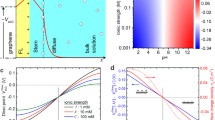Abstract
Molecular switches on solid surfaces raise an important issue in digital electronic devices. It has been frequently tried to design devices to perform basic functions at the molecular scale. In this paper, the Perdew-Burke-Ernzerhof (PBE) and PBE+van der Waals (vdW) were utilized in the framework of density functional theory (DFT) to model CO optimization on a graphene surface. Among the different external stimuli, electric fields serving as a useful probe were used to activate CO switching properties. The molecular conformation of CO, total dipole orientation, and charge transfer orientation were manipulated by turning an external electric field ON and OFF. The molecular conformation switched from a parallel orientation in a negative electric field towards a perpendicular orientation in a positive electric field. The total dipole moment switched from − 8.56 Debye (D) in an electric field of − 1.0 V/Å to 3.64 D in an electric field of + 1.0 V/Å. Charge transfer was seen to switch with the electric field switching. In the negative electric field, the charges were transferred from graphene to CO, while a reverse transfer occurred in the positive electric field. In addition, it was shown that CO desorption occurred in an electric field of greater than ± 1.0 V/Å. Eventually, the ON-to-OFF state transition was accompanied by switching between the positive and negative dipole moments, adsorption and desorption states, and positive and negative charge transfers when the external field direction and intensity were switched.






Similar content being viewed by others
References
Liu W, Filimonov SN, Carrasco J, Tkatchenko A (2013) Molecular switches from benzene derivatives adsorbed on metal surfaces. Nat Commun 4:2569
Zhang JL, Zhong JQ, Lin JD, Hu WP, Wu K, Xu GQ, Wee AT, Chen W (2015) Towards single molecule switches. Chem Soc Rev 44:2998–3022
McNellis E, Meyer J, Baghi AD, Reuter K (2009) Stabilizing a molecular switch at solid surfaces: a density functional theory study of azobenzene on Cu (111), Ag (111), and Au (111). Phys Rev B 80:035414
Trinastic J, Cheng H-P (2014) First-principles study of multicontrol graphene doping using light-switching molecules. Phys Rev B 89:245447
Weinelt M, von Oppen F (2012) Molecular switches at surfaces. J Phys Condens Matter 24:390201
K. Nakada, A. Ishii, Graphene Simulation, open access book edited by Jian Ru Gong, in, ISBN, 2011.
JoonáKim B, KyungáJeon E, HoáCho J (2012) Optical switching of the Dirac point in graphene multilayer field-effect transistors functionalized with spiropyran. Chem Commun 48:10978–10980
Simmons J, In I, Campbell V, Mark T, Léonard F, Gopalan P, Eriksson M (2007) Optically modulated conduction in chromophore-functionalized single-wall carbon nanotubes. Phys Rev Lett 98:086802
Kim M, Safron NS, Huang C, Arnold MS, Gopalan P (2011) Light-driven reversible modulation of doping in graphene. Nano Lett 12:182–187
Nguyen P, Li J, Sreeprasad T, Jasuja K, Mohanty N, Ikenberry M, Hohn K, Shenoy VB, Berry V (2013) Covalent functionalization of dipole-modulating molecules on trilayer graphene: an avenue for graphene-interfaced molecular machines. Small 9:3823–3828
Liu H, Lee JY (2012) Electric field effects on the adsorption of CO on a graphene nanodot and the healing mechanism of a vacancy in a graphene nanodot. J Phys Chem C 116:3034–3041
Farmanzadeh D, Tabari L (2013) Electric field effects on the adsorption of formaldehyde molecule on the ZnO nanotube surface: a theoretical investigation. Comp Theor Chem 1016:1–7
Ortiz-Medina J, López-Urías F, Terrones H, Rodríguez-Macías F, Endo M, Terrones M (2015) Differential response of doped/defective graphene and dopamine to electric fields: a density functional theory study. J Phys Chem C 119:13972–13978
Liu W, Zhao Y, Nguyen J, Li Y, Jiang Q, Lavernia E (2009) Electric field induced reversible switch in hydrogen storage based on single-layer and bilayer graphenes. Carbon 47:3452–3460
Wu W, Ao Z, Wang T, Li C, Li S (2014) Electric field induced hydrogenation of silicene. Phys Chem Chem Phys 16:16588–16594
Kong L, Enders A, Rahman TS, Dowben PA (2014) Molecular adsorption on graphene. J Phys Condens Matter 26:443001
Rad AS, Foukolaei VP (2015) Density functional study of Al-doped graphene nanostructure towards adsorption of CO, CO2 and H2O. Synth Met 210:171–178
Leenaerts O, Partoens B, Peeters F (2008) Adsorption of H 2 O, N H 3, CO, N O 2, and NO on graphene: a first-principles study. Phys Rev B 77:125416
Wang W, Zhang Y, Shen C, Chai Y (2016) Adsorption of CO molecules on doped graphene: a first-principles study. AIP Adv 6:025317
Ao Z, Li S, Jiang Q (2010) Correlation of the applied electrical field and CO adsorption/desorption behavior on Al-doped graphene. Solid State Commun 150:680–683
Wanno B, Tabtimsai C (2014) A DFT investigation of CO adsorption on VIIIB transition metal-doped graphene sheets. Superlattice Microst 67:110–117
Zhang Y-H, Chen Y-B, Zhou K-G, Liu C-H, Zeng J, Zhang H-L, Peng Y (2009) Improving gas sensing properties of graphene by introducing dopants and defects: a first-principles study. Nanotechnology 20:185504
Jiang Y, Yang S, Li S, Liu W, Zhao Y (2015) Highly sensitive CO gas sensor from defective graphene: role of van der Waals interactions. J Nanomater 2015:5
Santos EJ, Kaxiras E (2013) Electric-field dependence of the effective dielectric constant in graphene. Nano Lett 13:898–902
Acknowledgments
This work was supported by the Vice Chancellor for Research Affairs of Payame Noor University. F. Zarei appreciates Nano Structured Coatings Institute of Yazd Payame Noor University for financial support as well as computation resources during his studies.
Author information
Authors and Affiliations
Corresponding author
Additional information
Publisher’s note
Springer Nature remains neutral with regard to jurisdictional claims in published maps and institutional affiliations.
Rights and permissions
About this article
Cite this article
Zarei, F., Kazempour, A. & Behjatmanesh-Ardakani, R. Conformational switching of CO on graphene: the role of electric fields. J Mol Model 25, 343 (2019). https://doi.org/10.1007/s00894-019-4242-x
Received:
Accepted:
Published:
DOI: https://doi.org/10.1007/s00894-019-4242-x




